Often the most notable plants in the Southwestern landscape are those that have a distinct growth pattern. The spiky gray leaves of common sotol (
Dasylirion wheeleri) have long been used by people throughout the U.S. Southwest for texture and color contrast in the garden. When you add the fact that this plant thrives in nutrient-poor soils, full sun and drought conditions, it’s easy to understand why common sotol is a popular succulent in arid landscapes and even used in the more humid southeastern climates of Louisiana and North Carolina.
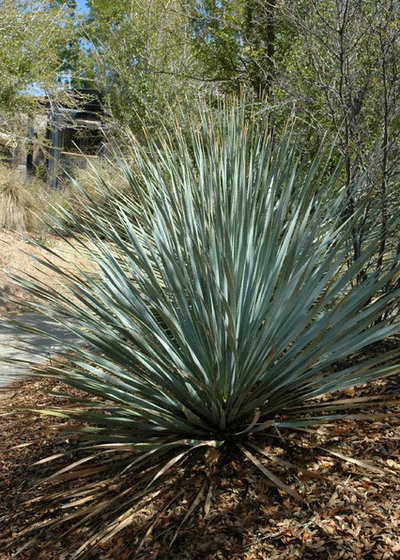
Noelle Johnson Landscape Consulting
Botanical name: Dasylirion wheeleriCommon names: Common sotol, desert spoon
Origin: Native to Arizona, New Mexico, Texas and northern Mexico
Where it will grow: Hardy to 0 degrees Fahrenheit (USDA zone 6; find your zone)
Water requirement: Drought tolerant once established, but looks best in low-desert climates when watered deeply once a month in the summer
Light requirement: Full sun to filtered shade
Mature size: Up to 5 feet tall and 6 feet wide
Benefits and tolerances: Drought tolerant
When to plant: Fall or spring
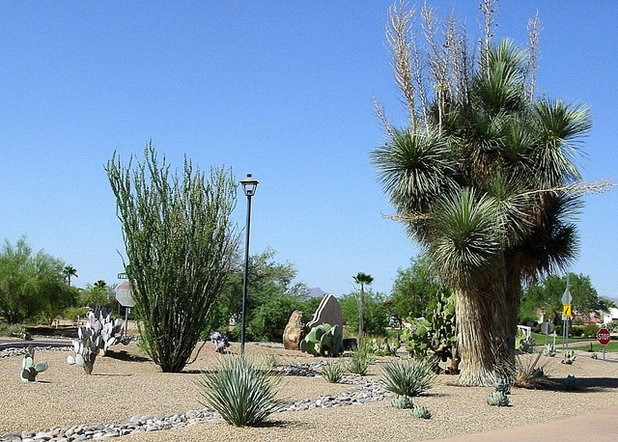
Noelle Johnson Landscape Consulting
Distinguishing traits. The blue-gray leaves of common sotol have small “teeth” along the edges, meaning that this succulent is best used away from areas with foot traffic. The upper halves of the leaves twist slightly, and the tips fade to a pale tan color; the tips become frayed over time due to weathering. Native Americans have used the fibrous leaves to create baskets and mats. An alcoholic drink, called sotol, is also made from desert spoon.
Shown: Common sotol planted in the foreground of a landscape filled with succulents
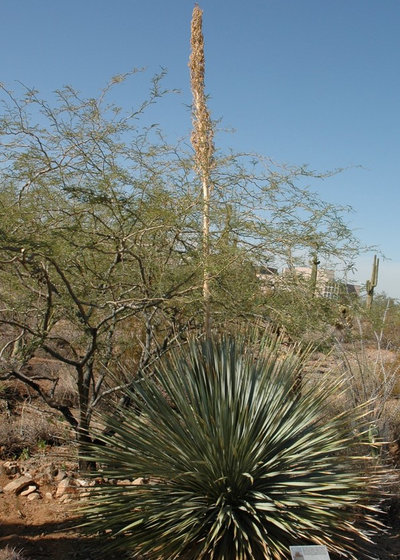
Noelle Johnson Landscape Consulting
In late spring and into summer, mature specimens of common sotol send up a flowering stalk that is cloaked in creamy white flowers that later fade to wheat-colored seeds. Common sotol will not always flower year after year, and unlike agave species, it will not die after flowering.
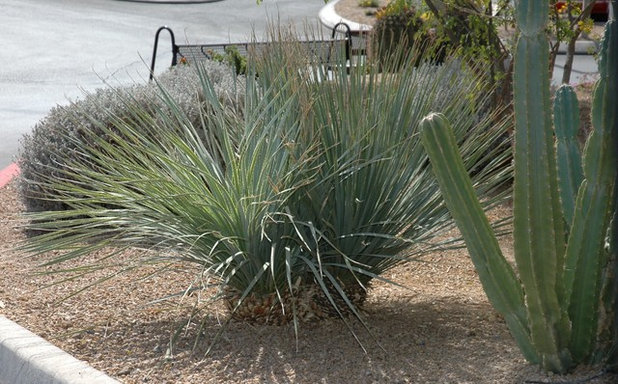
Noelle Johnson Landscape Consulting
Occasionally some common sotol plants will grow a second head, shown here, which doesn’t affect their use in the landscape.
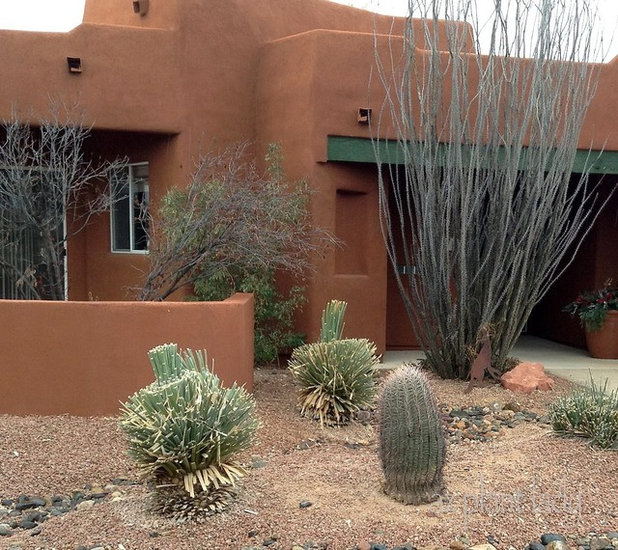
Noelle Johnson Landscape Consulting
As it ages, common sotol develops a short trunk (up to 3 feet high). Leaves toward the bottom will turn tan and die as they age. The dead leaves can be left alone or pruned to reveal the trunk.
Do not prune the upper leaves, which destroys the beauty of this desert native. The only pruning of common sotol is optional: You can remove the lower leaves, using hand pruners, after they have turned brown. The photo above shows how not to prune common sotol.
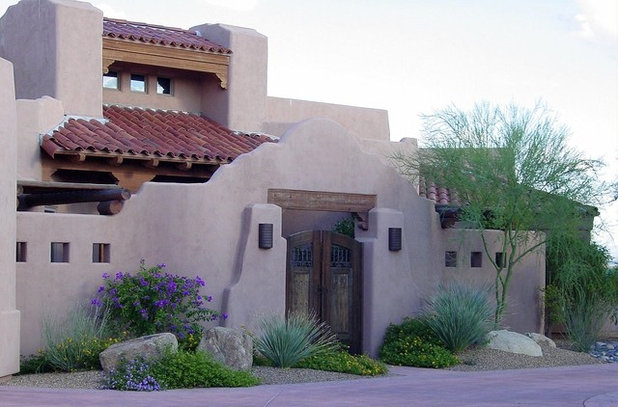
Noelle Johnson Landscape Consulting
How to use it. Common sotol is quite versatile in the landscape. Its gray-blue color and spiky texture are emphasized when it’s planted alongside the softer shapes of ground covers such as blackfoot daisy (
Melampodium leucanthum), damianita (
Chrysactinia mexicana),
lantana (
Lantana spp)
and
verbena (
Glandularia spp). Succulents with a more upright growth habit, such as ocotillo (
Fouquieria splendens), Santa Rita prickly pear (
Opuntia santa-rita)
and saguaro
(
Carnegiea gigantea),
also look great when paired with common sotol.
For a contemporary design, plant common sotol in single or staggered rows, making sure to allow enough room for the plants to grow to their mature size.
Shown: Spiky common sotol contrasting softer ground covers and shrubs
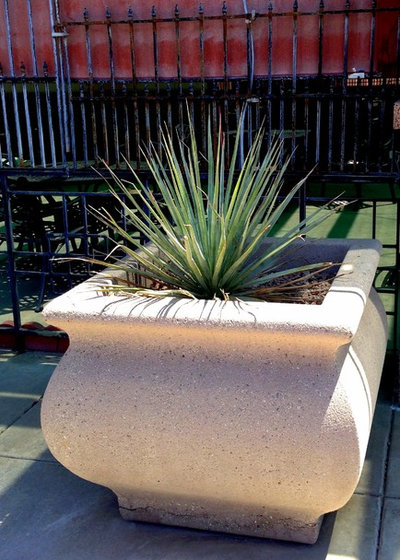
Noelle Johnson Landscape Consulting
This spiky desert native is able to handle a variety of tough conditions — including hot, reflected sun; drought; and winter cold — while creating interesting contrast in both color and texture when used alongside other plants. When it’s planted against an east- or west-facing wall, the spiky leaves create interesting shadows, which add to the plant’s ornamental value in the landscape. Common sotol also makes a great container plant and is the perfect choice for an area that is blasted with hot, reflected sun as well as a location with limited water access.
With its leaves and their saw-toothed edges, common sotol can be used as a natural security barrier to keep unwanted animals (or people) away from certain areas.
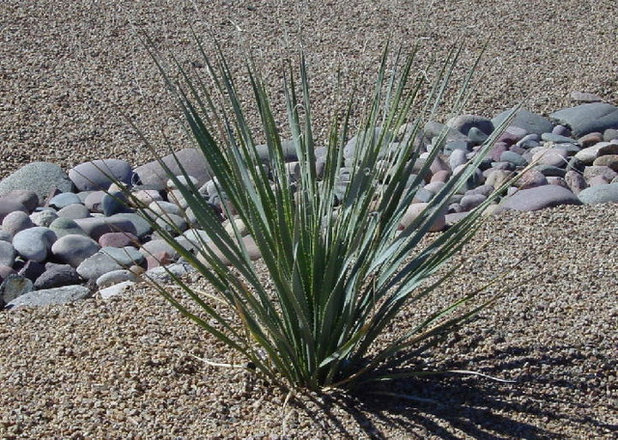
Noelle Johnson Landscape Consulting
Planting notes. While common sotol is most often found growing throughout the desert Southwest, some southeastern gardeners also include it in their landscapes. Whether you plant it in an arid or humid climate, the key to common sotol’s survival is well-drained soil. If drainage is a problem, create a raised mound where excess water will drain away. Because desert spoon is adapted to poor soils, no supplemental fertilizer is needed.
Water it for the first couple of years throughout the summer until it becomes established. Thereafter it can generally survive on rainfall alone, but its appearance will be improved if you water it once a month in low-desert climates in the summer months when rain is absent.





